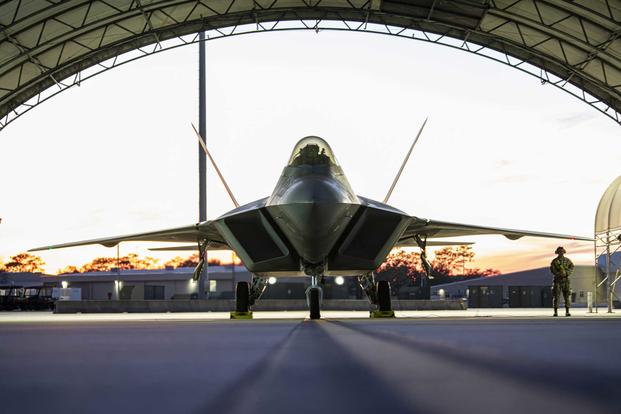Airmen began posting an image of an F-22 Raptor with its nose cone buried in the ground at Eglin Air Force Base, Florida, on Tuesday afternoon, after the aircraft had an apparent landing gear mishap earlier that morning.
Although the image was unverified, a statement from the 96th Test Wing at Eglin confirmed that the incident happened during landing around 10 a.m. and that emergency crews rushed to the scene immediately.
"The pilot was transported to flight medicine for an evaluation," the statement from Eglin said. "An investigation into the circumstances surrounding the mishap is underway."
Read Next: F-22 Has In-Flight Emergency, Ends Up Nose Down at Florida Base
Tuesday's incident highlights some long-standing issues with the F-22's landing gear and also follows a report released earlier this month that shows faulty landing gear springs were to blame for a high-profile mishap with a B-2 Spirit bomber in Missouri last year.
Mackenzie Eaglen, a senior fellow at the American Enterprise Institute who specializes in military readiness, said mechanical issues such as the ones faced by the F-22 at Eglin this week and the B-2 bomber last year cause serious problems for the force.
"There is a link between the age of aircraft requiring more maintenance, which leads to reduced flying hours," Eaglen said. "This is the smallest, oldest Air Force in history."
During last year's budget request, the Air Force wanted to slash flight time by roughly 87,500 hours because of the heavy costs associated with maintenance of many aging aircraft.
The pilot in Tuesday's incident at Eglin was medically cleared and released the same day, according to the base. The pilot was conducting a routine training mission, but no other details were provided.
An almost identical incident happened with an F-22 at Eglin last year, when a pilot experienced an in-flight emergency and the front landing gear didn't operate properly, causing the nose cone to dip into the ground on the runway.
After that mishap, the F-22 Raptors at Eglin -- and 10% of the fleet at other bases -- were inspected. Air Combat Command found that one in five of those jets had incorrectly rigged landing gear. Nearly 40 of those had to be fixed.
"Thirty-seven aircraft were re-rigged in accordance with the one-time inspection," Air Combat Command said in a statement last year. "The Program Office continues to explore potential root causes."
Additionally, Air Force Safety Center data shows that five Raptors had accidents in 2021, costing taxpayers upward of $600,000 each.
The F-22 mishaps come after the Air Force was forced to move the fleet from Tyndall in Florida following Hurricane Michael in 2018, spreading the planes out between Joint Base Langley-Eustis, Virginia; Joint Base Elmendorf-Richardson, Alaska; and Joint Base Pearl Harbor-Hickam, Hawaii.
In addition to the F-22 incident this week, more details emerged in a report from Air Force Global Strike Command showcasing what went wrong when a B-2 Spirit stealth bomber rolled off the runway at Whiteman Air Force Base in Missouri last year.
The plane, assigned to the 393rd Bomb Squadron of the 509th Bomb Wing, was also known as The Spirit of Georgia, and a photo of the mishap at Whiteman on Sept. 14 last year was widely shared on social media because of the jarring image of the massive aircraft slumped into the ground.
Both pilots in the incident were unharmed.
The report, released March 17, revealed that the damage estimate to the plane was around $10 million, but further review is still needed. Each bomber costs upward of $1 billion.
Air Force Col. Robert Cocke, the investigation board president, detailed in the report that the crash likely happened because lock springs on the landing gear failed to provide "sufficient pressure" to maintain a locked position.
No error was attributed to the pilot or the crew. But the report said that "there is no requirement for routine replacement of the lock link" springs. The last time the bomber went through in-depth maintence was 2014, according to investigators.
-- Thomas Novelly can be reached at thomas.novelly@military.com. Follow him on Twitter @TomNovelly.
Related: B-2 Rolled Off Runway at Whiteman in Emergency Landing













